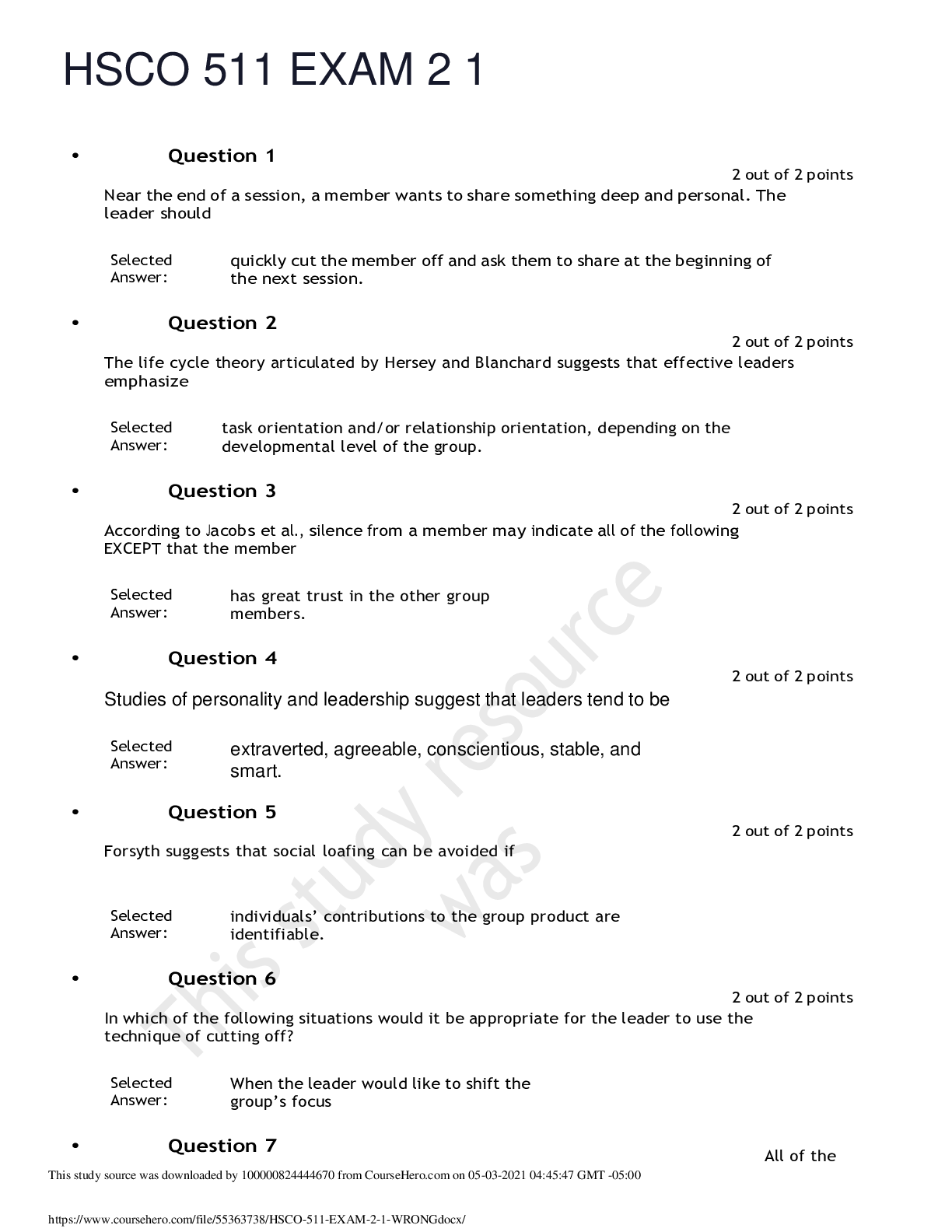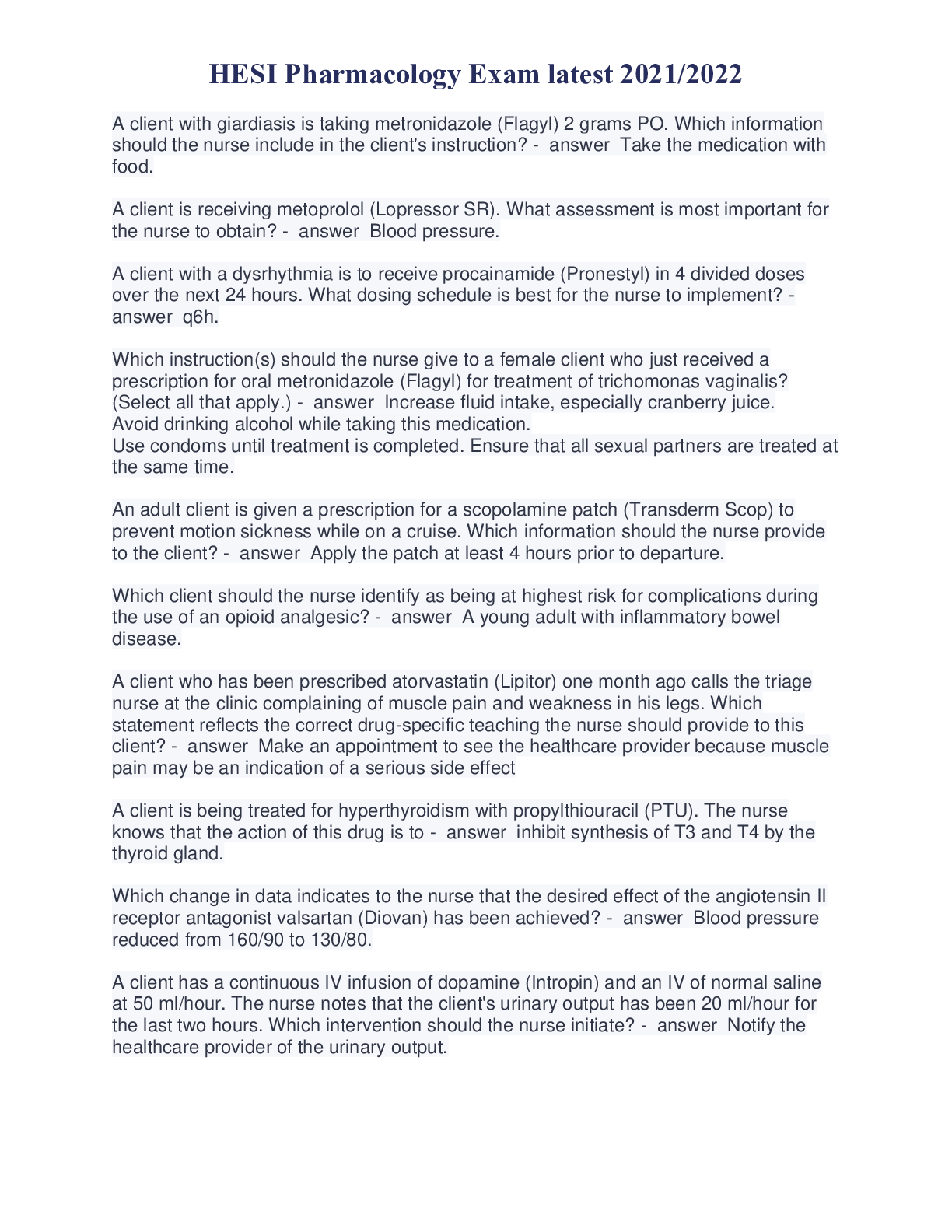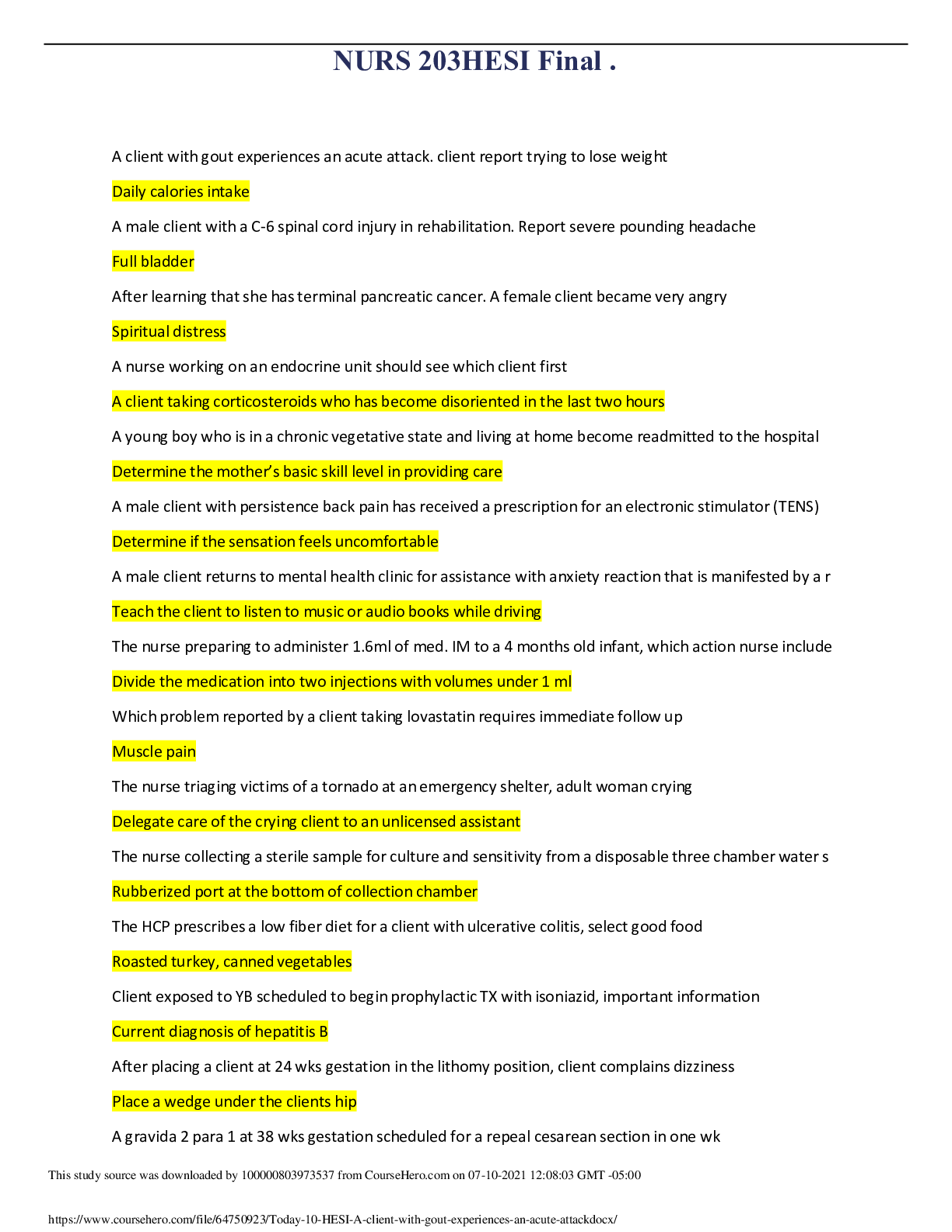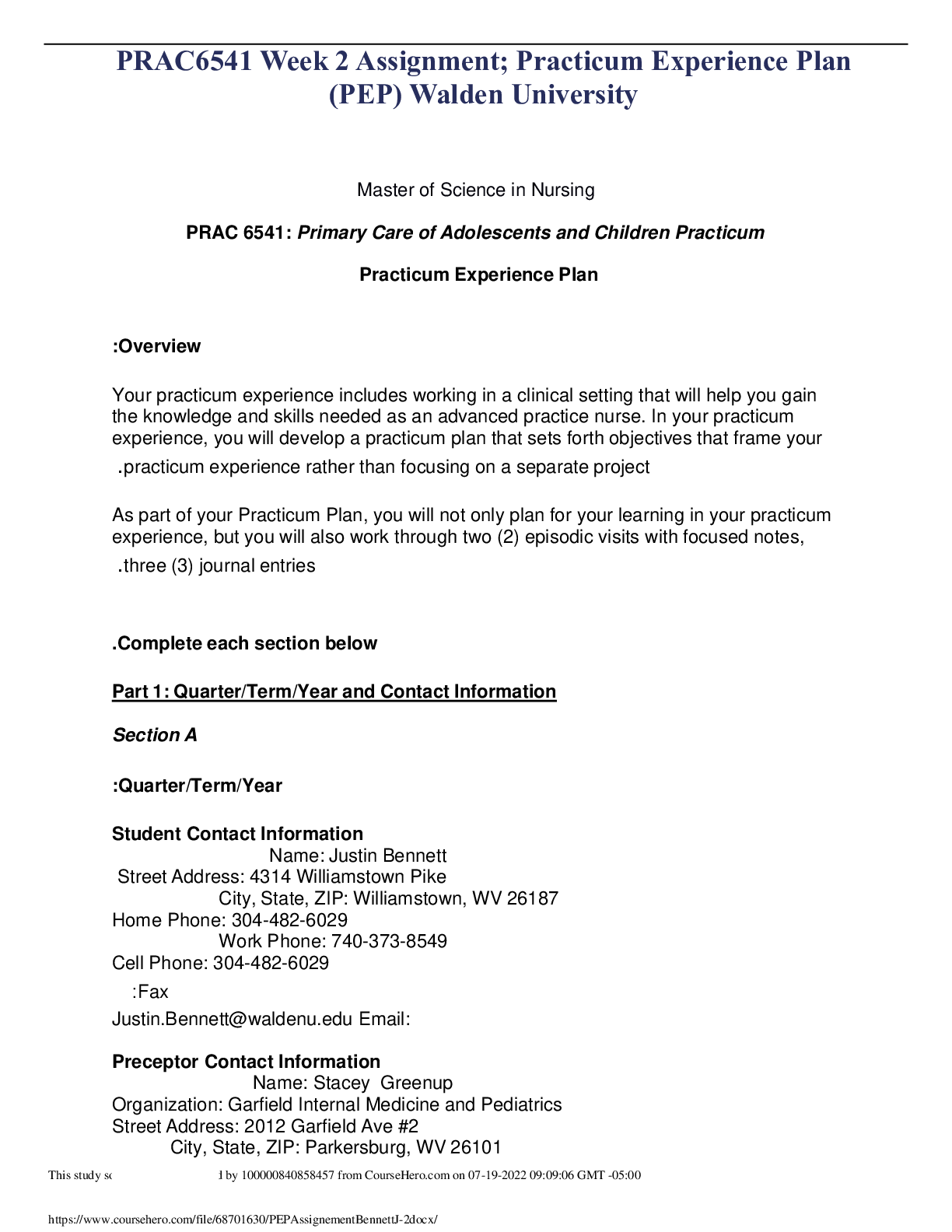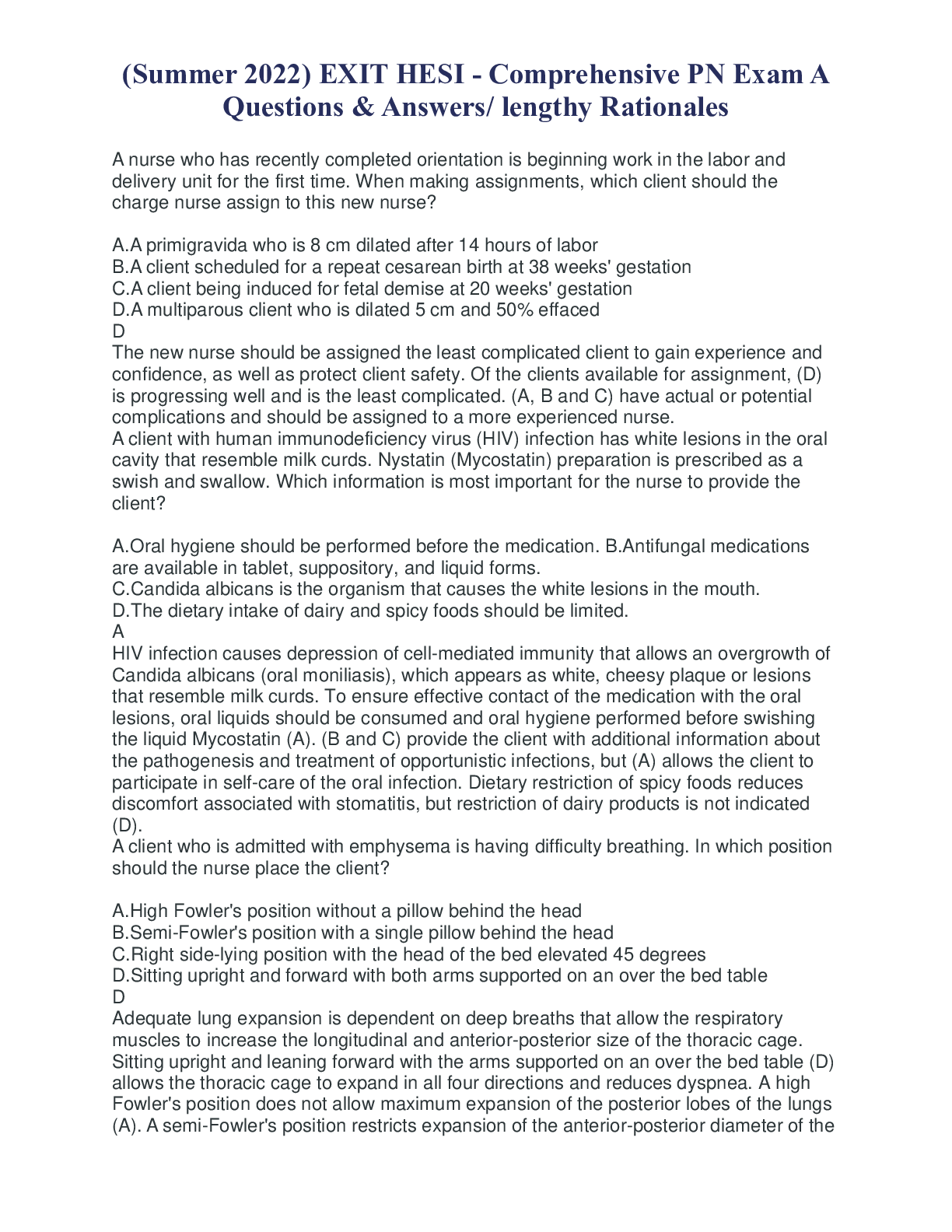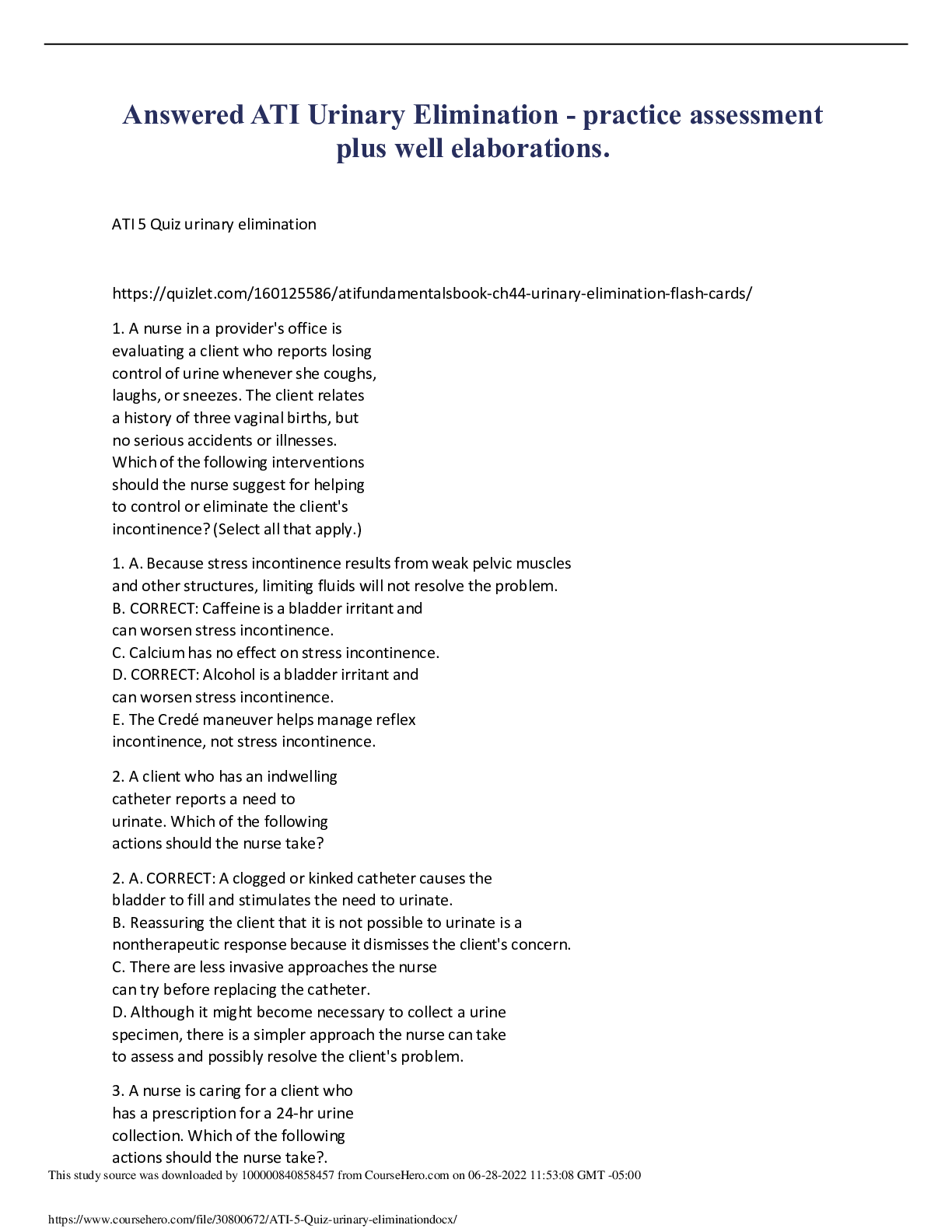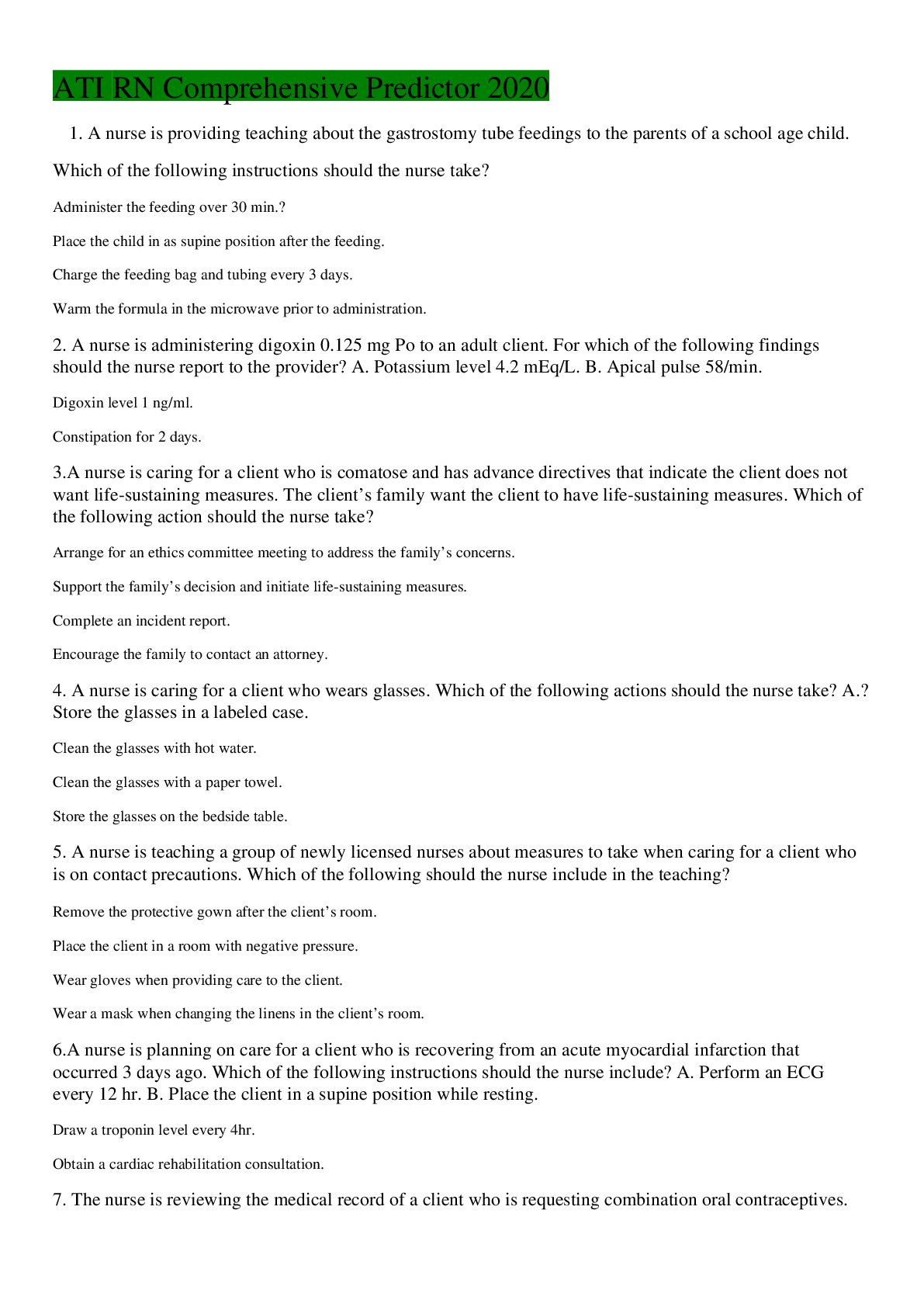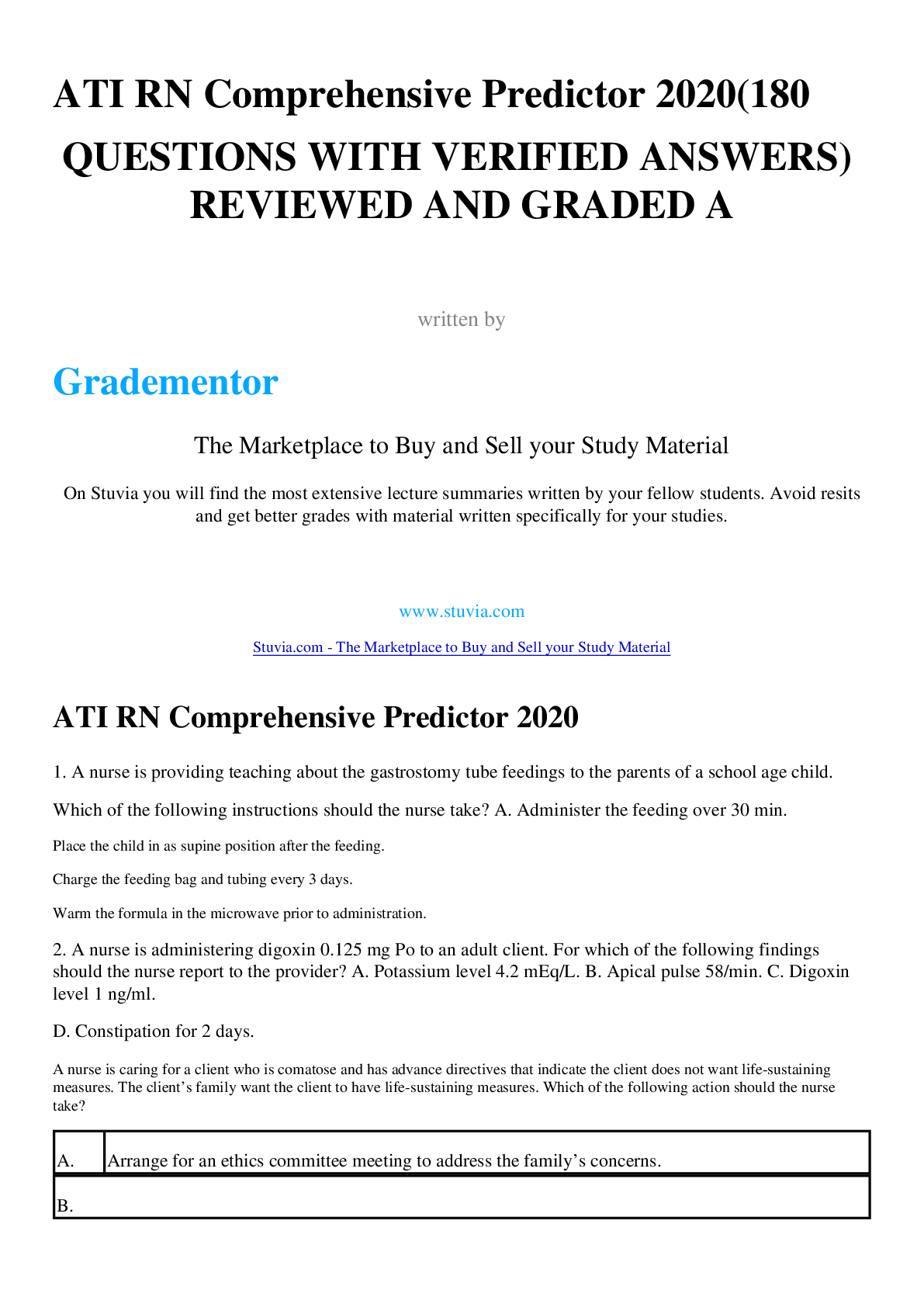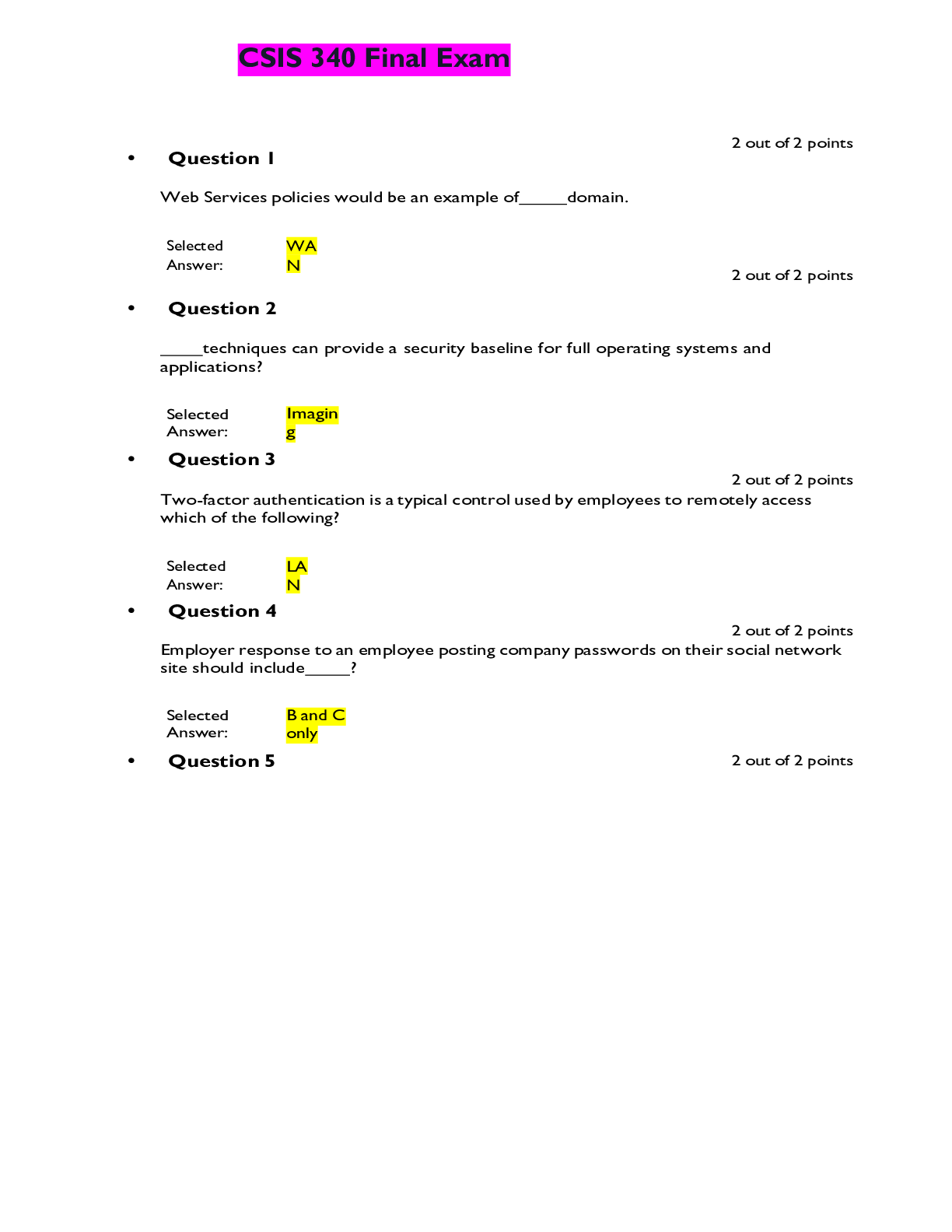*NURSING > EXAM > ATI Maternal Newborn Proctored Study Guide 2020/2021,WELL EXPLAINED WITH VERIFIED ANSWERS GRADED A. (All)
ATI Maternal Newborn Proctored Study Guide 2020/2021,WELL EXPLAINED WITH VERIFIED ANSWERS GRADED A.
Document Content and Description Below
Ch.1 Oral Contraceptives • Chest pain, SOB, leg pain (clot), headache, eye problems • Can cause blood clots • Hypertension • Do not use with smokers • Hx of blood clots, stroke, cardiac... , breast or estrogen • Depro-provera calcium and vitamin D • IUD= increased risk of pelvic inflammatory disease, ectopic pregnancy o Change in string length, foul smell, fever/chills, pain with intercourse notify provider Ch.2 Infertility • Inability for at least 12 months • Male first (sperm analysis), then the woman (no hx of dye for test or seafood) Ch.3 • Presumptive sign: things that can be explained by other means o Nausea, amenorrhea, N/V, Fatigue • Probable signs o Abdominal enlargements, Hagar sign, chad wicks sign, goodwill sign, ballottement, Braxton hick contractions, positive pregnancy test, fetal outline • Positive sign o FHR • Nagele’s rule: add 9 months and a week • GTPAl: Gravidity (# of times of pregnancy), Term births (38 weeks or more), Preterm births, Abortions/miscarriages, Living children Ch. 5 Nutrition During Pregnancy • Normal: 25-30 pounds • Overweight: 15-25 pounds • Underweight: 28-40 pounds • First trimester: no more than 2-4 pounds for entire trimesters.. then 1 lb/week • 340 calories/day for second trimester…450 for third trimester (even during breastfeeding) • Folic acid (dark leafy green veggies) fetal neuro tube defects • 2-3 L of water, limit amount of caffeine Ch.6 Assessment of Fetal Well being • Ultrasound want bladder full **non-invasive** • When poking stomach empty bladder (amniocenteses) • Biophysical profile: 0-10 score, 8-10 is normal o Reactive HR (0-2) o Breathing o Body movement o Fetal tone o Amniotic fluid volume • Nonstress test: measures fetal well-being in last trimester, response to FHR to fetal movement; reactive if FHR accelerates; non reactive if no FHR acceleration o YOU WANT REACTIVE • Contraction stress test o Want a contraction to occur ocycotcin, nipple stimulation; monitor FHR to see if decelerations occur o You want late decelerations • Amniocentesis o You want an empty bladder o AT 14 WEEKS o Levels of AFP (high nuero tube defects; low down syndrome) o L/S ratio: 2:1 ratio is fetal lung maturity (2:5:1 or 3:1 for a client who has diabetes mellitus) o Complications: amniotic fluid emboli, hemorrhage, infection • Chorionic callus sampling o Taking a piece of placenta o Can be done earlier to identify abnormalities ( 11 WEEKS) Ch. 7 Bleeding During Pregnancy • Ectopic: Unilateral stabbing pain; Lower abdominal quadrant pain • Molar: bleeding that resembles prune juice • Placenta previa: lower segment of uterus instead of fundus; PAINLESS bright red during 2nd or 3rd trimester may hemorrhage o Complete: cervical is completely covered by placental attachment o Partial o Incomplete • Abruptio placentae: sudden onset of intense localized pain with dark red vaginal bleeding Ch. 8 Infections • Yeast infection pretty common Ch. 9 Medical Conditions • Incompetent cervix cervical cerclage (placed at 12-14 weeks & removed at 37 weeks) • Hyperemesis: excessive N/V past 12 weeks; IV fluids, pyridoaxine (B6) administrations, antiemetic meds (Zofran) • Iron deficiency anemia: iron supplements with food rick in vitamin C (orange juice) • Gestational diabetes: higher risk for developing diabetes after pregnancy, (will likely do biophysiol profile and non-stress test) o Insulin to control sugar levels o Test b/w 24-28 wks one-hour glucose (no fasting required) over 140 will proceed with next test OTGG (requires fasting) 3 hours • Gestational hypertension: caused by vasospasm poor tissue perfusion o After 20 week; 0ber 140/90 positive o No protein in the urine o Mild preeclampsia: 1+ o Severe preeclampsia: 3+ o Eclampsia: seizures o HELLP syndrome: o Antihypertensive meds: methyldopa, nifedipine, hydralazine, labetalol o Magnesium!! to prevent seizures (monitor mg toxicity no reflexes, low urine output, low level of consciousness, low resp) ▪ Magnesium toxicity calcium gluconate (antidote) Ch. 10 Early onset of Labor • Preterm labor: 20-37 weeks o Swab of vaginal secretions (fetal fibronectin) o Administer nifidepine (calcium channel blocker) block calcium to suppress contractions o Magnesium sulfate- relax smooth muscle (watch for mg toxicity) o Indomethacin o Betamethasone (steroids) promote fetal lung maturity • Premature rupture of membrane o Nitrazine paper test (should turn blue) *yellow would be just urine* o Positive ferning test to conduct on amniotic fluid to verify rupture o May put on an antiobiotic (infection can cause rupture) (betamethasone) Ch.11 Labor and Delivery Processes • Back ache, weight loss (1-3 lbs), lightening (fetal to pelvis), contractions (Braxton hicks), increased vaginal discharge or bloody show, energy burst, GI changes • Labs: Group B streptococcus, urinalysis • Stages of labor: o Onset-complete dilation (10 cm): ▪ Latent: irregular (mild-moderate); every 5-30 min lasting 30-45 sec ▪ Active: regular (moderate-strong); every 3-5 min lasting 40-70 sec ▪ Transition: (strong-very strong); every 2-3 min lasting 45-90 sec (feeling of needing to poop) o Fully dilates-birth: o Birth-delivery of placenta: o Delivery to placenta-normal vital signs: Ch. 12 Pain management • Effleurage: light gentle circular stroking of the clients abdomen with fingertips in rhythm with breathing during contractions (cutaneous stimulation) • Resp. depression, decreased FHR, hypotension, sedation with opioid or sedative • Epidural: lack of sensations from umbilicus to thighs; dilated to 4cm or aboce; AE: hypotension fetal bradycardia, (IV bolus to counteract) avoid supine hypotension **do not lay on back Ch. 13 Fetal Assessment During Labor • 110-160 BPM; want moderate variability (NO LATE DECELERATIONS) **early ones are ok • Fetal bradycardia (due to epidural) disco oxytocin, place on side, provide oxygen • Fetal tachycardia (over 160) maternal infection (antipyretic and oxygen) • Late declaration (uteral placental insufficiency): side lying position, increase fluid, admin oxygen, disco oxytocin • Variable decelerations (umbilical cord compression): reposition clients side to side, knee chest position Ch. 16 Complications related to labor process • Prolapsed umbilical cord: displaced preceding the presenting part of the fetus or through the cervix o Use a sterile-gloved hand, insert two fingers into the vagina and apply finger pressure on either side of the cord to the fetal presenting part to elevate it off the cord o Reposition in a knee-chest, Trendelenburg or a side lying position with a rolled towel under the clients right or left hip to relive the cord o Apply warm sterile saline soaked towel to the visible cord Ch.17 Postpartum physiological adaptions • RhoGaM admin 72 hours after giving birth who are RH neg and baby is RH positive to prevent issues with next pregnancy • Fundus o 3rd stage of labor: palpable at midline and 2cm below to halfway b/w umbilicus and symphysis pubis o 12 hr postpartum: 1 cm above umbilicus o Every 24 hours after should descend 1-2 cm o 6 post partum halfway o By 10 day you shouldn’t be able to palpate • Lochia: discharge after birth o Rubra bright red color, some clot (1-3 days) o Serosa pinkish brown color (4-10 days) o Alba yellowish white creamy discharge with flush order (4-8 weeks) • Ice packs at perineum for first 24 to 48 hr, sitz baths at 100-104 degrees at least 2x a day • Milk 2-3 days after birth (before that is the colostrum) • Uterine atony: retaining urine (uterine to be displaced) o Have her go to the bathroom Ch. 18 Baby friendly Care • Phases of maternal role attainment o Dependent (taking in); 24-48 hr o Dependent-independent (taking-hold); 2-3 days o Interdependent (letting-go) Ch. 19 Discharge Teaching • Breast engorgement cold/warm compresses b/w feedings, warm shower prior to breastfeeding (increase milk flow and promote the let down reflex) • For non lacting patients fresh cold cabbage leaves Ch.20 Postpartum Disorders • Deep vein thrombosis: unilateral swelling in legs; postpartum at higher risk • Pulmonary embolism: chest pain, difficulty breathing • Postpartum hemorrhage: Uterine atony, retained placenta fragments; increase change in lochia pattern o Meds: oxytocin (uterine stimulant), methylergonovine , misoprostol o Uterine atony Massage fundus Ch. 21 Postpartum infections • Mastitis: infections in breast; painful or tender localized hard mass and reddened area usually on one breast; Chills, fatigue o Enlarged tender axillary lymph nodes with an area of inflammation that can be red, swollen, warm and tender • Hygiene: wash hands prior to breastfeed, air dry nipples, baby taking nipple and areola area when feedings, breast emptied during each feeding to prevent mastitis Ch.22 Postpartum depression • Blues: tearfulness, lack of appetite • Depression: within 6 mo of delivery, • Psychosis: hx of bipolar disease, hallucinations, obsessive behavior, paranoia Ch. 23 Newborn assessment • APGAR (0-2) total of 10; 0-3 severe distress; 4-6 moderate difficulty; 7-10 minimal to no difficulty o Heart Rate=- greater than 100/min is 2 o Resp rate o Muscle tone o Reflex- grimace is a 1 o Color- completely pink is 2 • New Ballard Scale- newborn maturity scale (neuromuscular and physical maturity) o Neuromuscular: square window, arm recoil, scarf sign, popliteal angle, heel to ear **they should be well flexed o Physical: ▪ Preterm: thinner skin, sticky skin, lanugo, flat smooth scrotum, flat labia ▪ Full term: thicker, plantar creases, breast tissue (5-10 mm breast buds) ▪ Late term: wrinkle, leather skin • Normal deviations o Milia: raised white spots o Mongolian spots: bluish purple spots • Head o Should be 2-3 cm larger than chest circumference o Anterior (diamond shape) and posterior fontanel (smaller and triangle shape) present o Caput succedaneum o Cephalohematoma • Eyes are blue at grey at first • Grey white patches on tongue indicate thrush a fungal infection (Candidiasis) • Reflexes o Sucking rooting reflex o Palmar grasp o Plantar grasp o Moro reflex o Tonic neck (fencer position) o Babinski reflex o Stepping Ch. 24 Nursing Care of Newborn • Thermoregulation o Conduction o Convection o Evaporation: drying newborn off o Radiation • Meconium- should be passed after 24 hours after birth (abnormal if it doesn’t happen) • Erythromycin ointment in eye to (gonorrhea, chlamydia) • Vitamin K needed to prevent hemorrhaging until they start producing their own • Hep B at birth, 1 mo, 6 mo • Hypoglycemia (jittery, twitching, weak high pitched vcy, cyanosis, lethargy, seizures, under 40 glucose level, irregular resp) Ch. 25 Newborn nutrition • Lose 5-10% body weight after birth • Breast feeding o Decrease risk of SIDS o First food introduced – iron o Start right after birth (uterine cramps release of oxytocin) o 15-20 min per breast (try to empty breast with each feeding) o Best indicator if they are eating right is based on diaper (6-8 diapers per day) o Stored at room temp for up to 8 hours, refrigerated must be used within 8 days, If frozen up to 6 mo, deep freezer, 12 mo. o Thaw milk in refrigerator o DO NOT microwave milk o DO NOT refreeze thaw milk o Used portions should be discarded (DO NOT use again) o Formula up to 48 hours Ch. 26 Nursing Care and Discharge teaching • Place baby on back (to prevent SIDS) • Newborns sleep 17 hours out of 24 • Cord care o Keep dry and above diaper o Give sponge baths only until it comes off (10-14 days after birth) o Makes sure it is NOT moist or red, foul odor, purulent drainage • Circumcision Care o Petroleum jelly o DO NOT wash yellowish mucus off o Give baby acetaminophen • Car safety o Rear end facing o Middle back seat until age 2 Ch. 27 New born complications • Hypoglycemia (less than 40) • Preterm: resp distress, bronchopulmonary dysplasia, aspiration, apnea, • Macrosonic newborn: born to mom with diabetes, hypoxia, hypoglycemia, hypocalcemia (tremors) • Post term: cracked, leather skin, long hair and nails • Hyperbilirubinemia o Jaundice (monitor time it set in) o Kernicterus (untreated) o Phototherapy primary treatment (greater than 15) ▪ Eye mask over baby ▪ Keep newborn undress ▪ Cover genital ▪ Avoid applying lotion ▪ Remove from phototherapy every 4 hours and check eyes ▪ Reposition every 2 hours ▪ Bronze/rash is not serious ▪ Monitor dehydration!!! (sunken fontanel); check diaper (feed frequently) [Show More]
Last updated: 2 years ago
Preview 1 out of 8 pages

Buy this document to get the full access instantly
Instant Download Access after purchase
Buy NowInstant download
We Accept:

Reviews( 0 )
$14.00
Can't find what you want? Try our AI powered Search
Document information
Connected school, study & course
About the document
Uploaded On
May 15, 2021
Number of pages
8
Written in
Additional information
This document has been written for:
Uploaded
May 15, 2021
Downloads
0
Views
52


